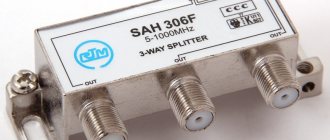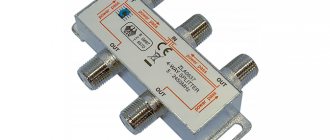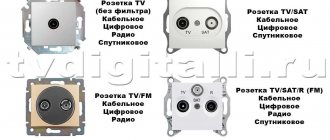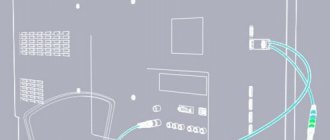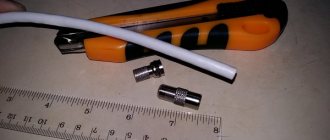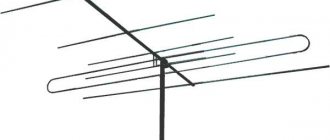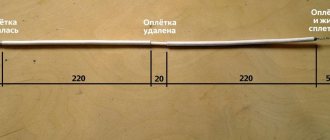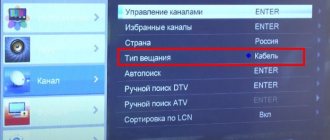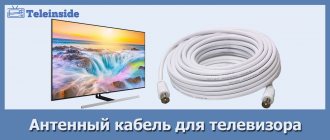Today you rarely find an apartment with only one TV. Usually there are two or even three. And the subscriber has a question about how to connect all devices to one antenna cable. It would seem that an elementary tee splitter will allow you to send a signal to three digital broadcast TVs. In practice this is not always the case. A divider or splitter for DVB T2 digital television must be selected in accordance with the structure of the cable network in the house.
Purpose and main differences
Splitters allow you to evenly divide a television signal between several outputs. For example, if the input signal level was 12 dB, then at the outputs of a double divider it will be 6 dB, a triple divider - 4 dB, and a quad divider - 3 dB.
Double splitter
The figure shows a schematic representation of a double splitter, where:
A – signal input;
B and C are the exit.
Antenna splitters of this type are used in cases where it is necessary to send a signal to 2 or 3 TVs, or more if the device has an amplifier (active splitter). An example is the model of the Polish manufacturer ARA-01A.
Diplexers allow you to combine two signals into one. Most adder models are universal; they can work in two directions, that is, act as an adder or a divider.
Dual diplexer
The figure shows a schematic representation of a double diplexer, where:
A and B – input signals;
C – output signal.
A diplexer is used in cases where it is necessary to run a signal from a satellite and a conventional antenna over one cable or combine signals from different ranges. The figure shows an example of using an adder and a divider together, where:
- A – television antenna;
- B – satellite dish;
- C – adder;
- D – socket with a built-in divider for connecting two television cables.
Scheme of joint use of an adder and a divider
. Taps are used to organize a backbone television network, for example, to divert a signal to apartments in a multi-story building.
Highway organization diagram
The figure shows an example of organizing a highway using several taps, where:
- A – incoming signal;
- B, C, D, E, F, G, H, I, J – signal output (tap), for example, to each floor of a nine-story building.
As can be seen from the connection diagram, such devices have one pass-through output, from which the signal is supplied to the input connector of the next coupler.
Video: TV antenna splitter.
Antenna splitters can also include a range blocker (stub), which is widely used by cable television operators to separate social and paid connection packages.
In everyday life, splitters are most often used; they are used to connect several televisions to the antenna cable entering the apartment; the quality of the television signal directly depends on these devices.
Installation Rules
The rules for installing dividers on two, three or more digital broadcast televisions are based on the structure of the cable network. It can always be considered as a collection of several segments with one of two standard types.
Equilibrium structure
The most clear example of a balanced network is an antenna installed on the roof and cable routing through the ceiling of the top floor of the house. In this case, the length of the leads to the consumers is almost the same. This means that it is enough to install dividers to evenly distribute the signal between TVs.
Nonequilibrium structure
You can understand what a nonequilibrium structure is using the example of a multi-room apartment. At one point there is a digital television cable. From it to the first consumer there is a short line, to the next a longer and record length line to the TV in the farthest room.
In this case, it is recommended to install splitters and create a uniform signal distribution. For simplicity, let's look at an example with three TVs. The first splitter is installed at the entrance (apartment cable). Its low-power branch is switched to a short line. The main output is connected to the next splitter. Its powerful signal is sent to the long line, a branch to the remaining one.
Advice! In a complex network, it is always recommended to simplify to simple segments. In this case, it is worth taking into account the number of consumers in each and, if there is an obvious imbalance, use signal splitters to redistribute power.
How to choose
First of all, it should be taken into account that the operating frequency of antenna splitters for digital television and satellite dishes is different. For the former it is limited to 1 GHz, for the latter it is 2.5 GHz. In addition, the satellite splitter may have a “Powerpass” function (allows you to supply power to the satellite dish head).
Note that a satellite splitter can also be used to split a digital or analog signal.
The second parameter that you should pay attention to is signal attenuation; as a rule, its value is indicated on the device body; the lower it is, the lower the losses.
It is also important who the manufacturer of the device is. Products from such well-known manufacturers as: Lans, Rexant, Premier, TAH, Luxmann, Alda, Hama, Sat, etc. will give an output signal an order of magnitude better than Chinese or homemade splitters.
Device settings
When choosing, you need to take into account the technical parameters of the device:
- The attenuation level indicates how much the signal transmission power through this device is reduced. The smaller this value, the better the device works.
- A splitter is designed to distribute the incoming signal between several television receivers. Typically the number of recipients is from two to eight. It is important that the number of outputs corresponds to the number of pieces of equipment. There are also splitters for 16 recipients, but such models are relatively rare.
- Bandwidth characterizes the frequency range used. In most cases, for terrestrial television it is 5-1000 MHz, and for satellite television it is 5-2500 MHz.
- An active antenna splitter additionally uses an amplifier. It is capable of providing increased power during signal transmission. Such devices are more expensive and can work with no more than two devices.
When choosing a splitter, its parameters must correspond to the specific situation of the buyer. If not all connectors will be used, it is recommended to install plugs on the remaining ones.
The device indicates the degree of signal attenuation for each connector Source stroy-podskazka.ru
How to connect
The instructions for connecting the splitter are quite simple:
- select a location and attach the divider to it;
- Next, you need to remove the plug from the antenna splitter (do this operation for each connector);
- use a coaxial cable (adapter) to connect the input to the TV and the jack;
- connect the television cable entering the apartment.
At this point the installation can be considered complete; installation takes no more than 10 minutes.
Selecting a TV cable
You should be very careful when choosing a television cable. The wire largely determines the quality of the television image on televisions remote from the main antenna input. All types of TV cable have a standard characteristic impedance value. It is 75 ohms.
However, different types of cable have different attenuation. Its value is not indicated directly on the cable. The attenuation value can be found on special websites on the Internet. The attenuation of a cable, or rather its specific attenuation, is expressed by a number with the dimension dB/m. The most suitable will be the one with this value the smallest compared to the others.
The longest sections of cable routes laid in an apartment have the greatest attenuation. If you do not prepare for the purchase in advance, then if you have a choice, you should buy the cable that has the largest diameter of the outer sheath. It has less attenuation compared to others.
Do it yourself
It’s not difficult to make a splitter for analog television with your own hands; here are some simple diagrams of such a device.
Passive splitter with resistors.
Separator circuit for two and three devices
The figure shows two diagrams:
- a – for connecting two TVs (R1, R2, R3 = 25 Ohm);
- b – for connecting three TVs (R1, R2, R3, R4 = 36 Ohm).
Below is an example of a printed circuit board layout for circuit “b”.
Splitter board for three devices
The assembled device must be placed in a special case (any metal box will do for this), which should preferably be grounded. If the grounding is incorrect, interference in the form of snow may occur. Actually, it is better not to ground at all than to do it incorrectly.
If the image on the TV screen is double, you should put a ferrite ring on the coaxial cable between the splitter and the TV.
Active splitter circuit.
In cases where you have a low level of the incoming television signal, you can correct the situation using a divider that has a broadband frequency amplifier. The diagram of such a device is shown in the figure below.
Divider circuit with antenna amplifier
Parameters of the elements indicated in the diagram:
- R1-10 Ohm;
- R2, R4, R5 – 430 Ohm;
- R3 – 30 kOhm;
- R6 – 150 Ohm;
- R7 – 470 Ohm;
- R8-R10 – 43 Ohm;
- C1, C2, C4 – 150 pF;
- C3 – 0.01 µF;
- VT1 – VT2 – KT399A;
Choke L1 is a frameless coil wound with PEV-2 wire with a cross-section of 0.4 mm, the diameter of the coil is five millimeters, there are 4 or 5 turns.
You can use batteries to power the circuit, but it is better to take a power supply for this. In the latter case, the transformer may create interference, so it is advisable to place the power supply in a separate housing. That is why it is advisable to install the splitter in a wireless zone, that is, where there is no electrical wiring.
Note that the above antenna splitter circuits have proven themselves to be effective in dividing analog signals; as for satellite and digital television, it is better for them to buy a ready-made device than to make it yourself.
Do I need an amplifier?
If you need to connect several TVs to one antenna at once, you need to keep in mind: using a splitter of any design, the signal is still divided in half, and if 3 tuners are connected, then each gets only a third. Therefore, in most cases you need to connect an amplifier.
It will definitely be needed in situations where:
- the signal has good quality, but low power;
- two or more splitters are installed;
- long connecting cables are used.
In addition, the amplifier will most likely be superfluous when using cable and satellite TV. For them, the main thing is not to degrade the incoming signal, and the amplifier inevitably introduces distortion.
Finally, if the signal is critically weak, the amplifier is useless. It will not be able to raise the TV signal received by the antenna to the required level: there is simply nothing to amplify.
Price overview
As an example, we chose the Luxmann SP-202 splitter, which allows you to connect two TVs to one antenna cable.
| City | Cost (USD) | City | Cost (USD) |
| Ekaterinburg | 4 | Penza | 4,2 |
| Krasnoyarsk | 4,1 | Minsk | 4,1 |
| Moscow | 3,8 | SPb (Petersburg) | 3,85 |
As can be seen from the table, the price of an antenna splitter in Moscow, Krasnoyarsk, Minsk and other cities does not vary much. How economically profitable it is to make it yourself or buy it is up to you to decide.
Making a connection
Please note the following when connecting cables:
- If the device has coaxial jacks, then you can connect any type of cable to them using regular antenna plugs.
- When threaded connections are present in the splitter, it is assumed. That the connection will be made using a thin cable.
- For screw terminals, any type of cable can be used.
In order to make a connection, you must perform the following steps:
- Secure the splitter using the chosen method. This can be done by mounting it on the wall, fixing it on the TV receiver mounts, in a special niche, or in a plastic box.
- The rivets must be removed from each splitter connector.
- Cables from TVs are connected to the corresponding sockets.
- Insert the antenna cable.
After this, you can start viewing available programs. After installation is complete, you need to check the image quality. If it is not high enough, it is recommended to use a more powerful antenna, or use an active TV divider.
Bonus: we connect 2 TVs without adapters
According to amateur TV experts, in some cases adapters in the form of dividers are not only unnecessary, but even harmful.
Experts suggest the following scheme:
- An antenna and two coaxial cables are taken.
- The ends are trimmed. The distance at which the top insulation needs to be removed is determined experimentally.
- The braid and foil of the cables are unraveled and a general twist is made from it. The central wires remain separate.
- These two wires are fastened with screws to a regular place in the antenna. A twist of shielding material is attached in the same place where the shield of a single cable should normally be located. The main thing is to ensure that the cores do not come into contact with the screen.
However, it is technologically more difficult, in addition, it changes the characteristics of the circuit in an unpredictable way, so you can use this connection option, but the result is not guaranteed.
